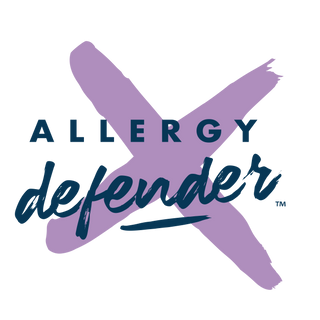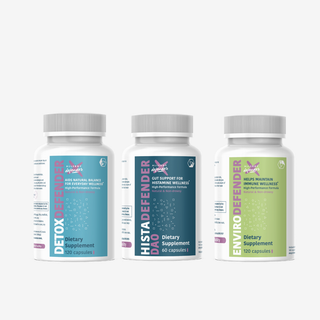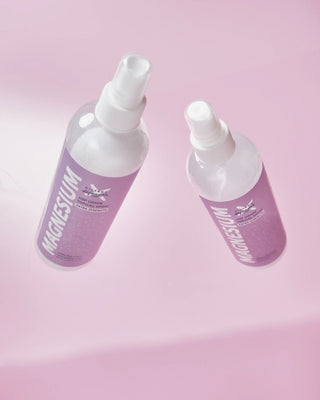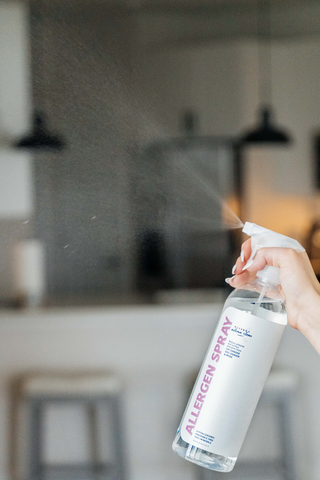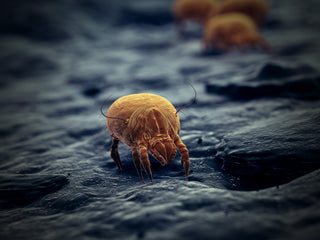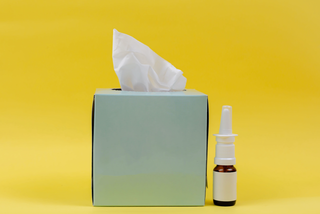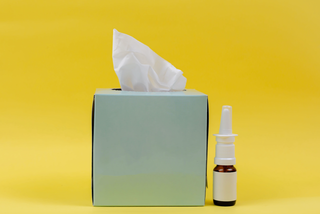Ever get a headache after cleaning your bathroom? You're not alone! Many common cleaning products contain harsh chemicals that can irritate your skin and lungs and even disrupt your hormones. The good news? There's a healthier way to achieve a sparkling clean home. This guide unveils the dangers of traditional products and showcases the power of natural alternatives. By making the switch to non-toxic cleaning, you can breathe easier, create a safer environment for you and your family, and contribute to a healthier planet. What's not to love?
The Trouble with Traditional Cleaners
They promise gleaming floors, sparkling countertops, and germ-free surfaces, but lurking beneath the seemingly harmless suds of many traditional cleaning products lies a hidden danger: a cocktail of toxic chemicals. These chemicals, often listed with unrecognizable names on the label, can have a significant impact on your health and well-being.
Here's a closer look at some of the common culprits that could be hiding in your cleaning cabinet or under your sink.
Chlorine Bleach: This powerful disinfectant is effective at killing germs, but it can also irritate the skin and respiratory system. When mixed with other cleaning products, it can create toxic fumes. A study published in the National Library of Medicine found a link between exposure to household cleaning products containing chlorine bleach and increased risk of asthma in adults.
Ammonia: This pungent (it is quite overpowering, actually) ingredient cuts through grease but can trigger respiratory problems, especially for those with asthma. Long-term exposure can also irritate the eyes and skin. Research published in 2023 suggests ammonia can cause asthma, chronic cough, or lung fibrosis. As a side note: you've heard of smelling salts? It's an ammonia inhalant that is used to revive people who have fainted or are feeling lightheaded. Ammonia is that strong and overwhelming.
Phthalates: These chemicals are used to make plastics more flexible and are often found in air fresheners and fragranced cleaning products. Phthalates are endocrine disruptors, meaning they can interfere with your hormones (for more information see below under Fragrances: A Deceptive Delight, Endrocrine Disruptors). A large body of research, suggests that exposure to phthalates may be linked to various health problems, including hormonal imbalances, developmental issues in children, and certain cancers. If you can't give up some cleaners, some products will say they are phthalate-free.
Triclosan: This antibacterial agent is added to some soaps and cleaning products but has been linked to antibiotic resistance and endocrine disruption. The U.S. Food and Drug Administration (FDA) has banned triclosan from certain consumer products due to concerns about its potential to contribute to antibiotic resistance.
Antibacterial products, including soaps, pose a significant problem. Overuse of antibacterial soap, for instance, can lead to the development of antibiotic-resistant bacteria, also known as ‘superbugs.' These are more challenging to treat with traditional antibiotics, thereby posing a significant public health threat.
More importantly, antibacterial soaps can be endocrine disruptors, too! And they are no more effective than good old plain soap and water. And if you're using antibacterial soap, did you know it is ineffective against common illnesses caused by viruses, such as the cold or flu?
The Invisible Threat: Fragrances and VOCs
While the chemicals listed previously raise red flags, there's another category of hidden nasties lurking in cleaning products: fragrances and volatile organic compounds (VOCs). These may seem less concerning because of their pleasant scents, but the reality is that they can also pose health risks.
Fragrances: A Deceptive Delight
Fragrances are often added to cleaning products to mask unpleasant odors (lemon scents to mask ammonia, for example). However, the term "fragrance" is an umbrella term encompassing a multitude of undisclosed chemicals. A single fragrance can contain hundreds of different ingredients, and manufacturers are not required to disclose the specifics on product labels.
These undisclosed chemicals can be problematic for several reasons:
-
Potential Allergens: Many fragrance chemicals are common allergens, triggering skin irritation, respiratory problems, and even migraines in sensitive individuals. A study published found that fragrance mixes are a leading cause of allergic contact dermatitis, a skin condition characterized by itching, redness, and irritation.
-
Endocrine Disruption: Some fragrance chemicals have been linked to endocrine disruption, meaning they can interfere with the body's hormonal system. This site explains endocrine disruptors and where they are found. In the real world, examples of endocrine disruption include breasts in men, missed, late, or heavier or lighter periods than normal, reduced sperm counts leading to infertility, and earlier onset puberty in children.
VOCs: The Off-Gasing Culprits
VOCs are a class of organic chemicals that easily evaporate at room temperature. Many cleaning products contain VOCs, which contribute to their strong odors. While some VOCs pose minimal health risks, others can irritate the eyes, nose, and throat and even trigger headaches and nausea.
VOCs are not only found in cleaning products; plenty of items in your house have off-gas VOCs, too, such as pressboard furniture, cabinets, stain-resistant fabrics on upholstery, and more.
Exposure to VOCs is a particular concern for individuals with asthma, as it can aggravate symptoms and lead to asthma attacks.
Interestingly, a study published found that green cleaning products were slightly better at reducing the VOC load.
This brings us to why you want to use more natural compounds to clean, but first, a quick rundown on the harm done by harsh chemicals.
Why Essential Oils Aren't Always the Answer for Natural Cleaning
Essential oils, while seemingly natural, can pose challenges for those with asthma. These concentrated plant extracts contain volatile organic compounds (VOCs) that irritate the airways, triggering coughing, wheezing, and shortness of breath. Furthermore, many essential oils are common allergens, and exposure can lead to allergic reactions ranging from mild skin irritation to more severe respiratory problems. Even the pleasant fragrances of essential oils can be overwhelming for asthmatics, exacerbating symptoms and creating a feeling of stuffiness or difficulty breathing. In short, essential oils, despite their natural appeal, may not be the best choice for a truly asthma-friendly cleaning routine. And certain essential oils can be toxic to pets when used in the home. As a side note, I am asthmatic and cannot use or be near essential oils at all.
The Unwanted Consequences: How Traditional Cleaners Impact Your Health
Harsh chemicals lurking in many traditional cleaning products can have a significant impact on your health and well-being. Here's a quick summary at some of the potential consequences of exposure:
-
Respiratory Irritation: Many cleaning chemicals, like ammonia and chlorine bleach, can irritate the airways, causing coughing, wheezing, and shortness of breath. This can be particularly problematic for individuals with asthma, as it can trigger asthma attacks.
-
Endocrine Disruption: Some chemicals, such as phthalates and triclosan, can mimic hormones in the body and disrupt the endocrine system. This can lead to a variety of health problems, including hormonal imbalances, developmental issues in children, and certain cancers.
-
Eye Irritation: Exposure to cleaning product fumes can irritate the eyes, causing redness, watering, and stinging.
-
Headaches and Dizziness: Certain chemicals, like VOCs and some fragrance components, can trigger headaches, dizziness, and nausea.
The Power of Natural Cleaning Solutions: A Breath of Fresh Air
Imagine cleaning your home without harsh chemicals, stinging fumes, or the worry of harming your health. Natural cleaning solutions offer a breath of fresh air, both literally and figuratively. These effective yet gentle alternatives harness the power of natural ingredients to leave your home sparkling clean without compromising your well-being.
Here's a closer look at some natural cleaning heroes:
-
Vinegar: A great cleaner, its acidic properties make it effective at cutting through grease, grime, and soap scum. Diluted with water, vinegar can be used to clean some countertops, floors, windows, and even appliances. Use caution when working with vinegar if you an asthmatic, open a window, use ventilation and do not use concentrated vinegar. In our neck of the woods, we have very hard water. Instead of scrubbing the shower all the time, I simply rinse the shower with vinegar- hard water "stains" are eliminated quite easily.
-
Baking Soda: This versatile powder is a natural deodorizer, scouring powder, and mild abrasive. Baking soda absorbs unpleasant odors and can be used to freshen carpets, upholstery, and pet beds. It's also effective at scrubbing away baked-on grease and removing light stains. We use it on our kitchen sink and it feels safer to use than a popular scouring power. It's been around for decades.
-
Lemon Juice: A natural cleaner lemon juice is a great choice for tackling tough stains and water marks. It can also be used to lighten and brighten surfaces.
-
Castile Soap: Made from vegetable oils, castile soap is a gentle yet effective all-purpose cleaner. It can be diluted with water for a variety of cleaning tasks, from mopping floors to washing dishes.
- Sodium Sequicarbonate: Meet the original natural cleaner used for over centuries, making it a true powerhouse. Sodium sesquicarbonate is more alkaline than baking soda, making it effective at tackling tougher grease, grime, and stains. It natural water softener, tackling hard water issues and is more eco-friendly than other plant based cleaners. Compared to harsh chemical cleaners, sodium sesquicarbonate is the ultimate cleaning product ingredient. Find out why we use sodium sesquicarbonate in our Allergen Spray and the science behind why it works for allergens.
This eco-conscious approach to cleaning offers three advantages:
1.) Safer for Your Family and Pets
Harsh chemicals found in traditional cleaning products can be harmful if accidentally ingested or inhaled, especially by curious children and pets. Non-toxic cleaning solutions minimize these risks, creating a safer environment for everyone in your household.
2.) Gentle on Your Skin and Surfaces
Many traditional cleaners contain harsh ingredients that can irritate the skin and damage delicate surfaces. Non-toxic cleaning solutions are gentler on your skin and less likely to cause dryness or irritation. They are also kinder to your furniture, floors, and other surfaces, helping them last longer.
3.) Environmentally Friendly
Traditional cleaning products often contain harmful chemicals that can pollute waterways and harm ecosystems when they are washed down the drain. Non-toxic cleaning solutions are typically biodegradable and less toxic to the environment, making them a more sustainable choice.
